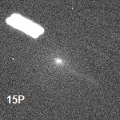
|
It brightened very rapidly. Now it is very bright as 10.8 mag (July 10, Carlos Labordena). It stays 10 mag until August. It stays observable in the morning sky for a long time.
Date(TT) R.A. (2000) Decl. Delta r Elong. m1 Best Time(A, h)
July 17 3 56.87 19 39.4 1.179 0.993 53 10.1 3:16 (261, 23)
July 24 4 27.20 21 52.2 1.217 1.004 52 9.9 3:23 (260, 25)
|
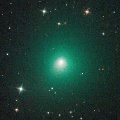
|
Now it is very bright as 10.2 mag (July 11, Osamu Miyazaki). It stays observable at 10 mag in good condition for a long time from spring to summer.
Date(TT) R.A. (2000) Decl. Delta r Elong. m1 Best Time(A, h)
July 17 14 7.15 2 44.4 1.715 2.056 94 10.1 20:55 ( 55, 43)
July 24 14 15.88 -0 21.7 1.779 2.060 90 10.2 20:49 ( 55, 38)
|
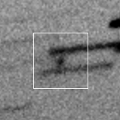
|
Now it is 16.1 mag (June 8, Ken-ichi Kadota). Brightening very rapidly. It will brighten up to 8.5 mag from September to October. But the condition is bad in this apparition. In the Northern Hemisphere, it is observable only in the extremely low sky until July. In the Southern Hemisphere, it will be observable after late August. But it stays locating low for a while. It is fainter than this ephemeris recently.
Date(TT) R.A. (2000) Decl. Delta r Elong. m1 Best Time(A, h)
July 17 6 23.83 32 45.3 2.092 1.204 21 11.7 3:16 (231, 3)
July 24 6 48.32 29 13.2 2.039 1.154 21 11.2 3:23 (235, 2)
|
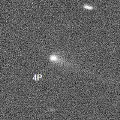
|
Now it is 12.3 mag (July 8, Thomas Lehmann). It will brighten up to 10 mag from summer to autumn, and it will be observable in excellent condition.
Date(TT) R.A. (2000) Decl. Delta r Elong. m1 Best Time(A, h)
July 17 2 41.74 16 18.4 1.738 1.709 71 11.6 3:16 (275, 36)
July 24 3 1.15 17 10.6 1.672 1.688 73 11.4 3:23 (277, 40)
|
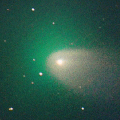
|
Now it is very bright as 11.2 mag (July 12, Chris Wyatt). It stays bright as 10-12 mag until August. In the Southern Hemisphere, it stays observable in excellent condition for a long time. In the Northern Hemisphere, it becomes extremely low after July.
Date(TT) R.A. (2000) Decl. Delta r Elong. m1 Best Time(A, h)
July 17 23 53.43 -40 48.1 0.522 1.381 124 11.5 3:16 (349, 13)
July 24 0 2.14 -43 58.0 0.554 1.420 127 11.6 3:23 (354, 11)
|
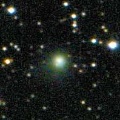
|
Now it is 12.2 mag (June 17, Thomas Lehmann). It will brighten up to 10 mag in winter in 2022. In the Northern Hemisphere, it stays observable in good condition for a long time, although it became extremely low temporarily from May to June. In the Southern Hemisphere, it is not observable until November.
Date(TT) R.A. (2000) Decl. Delta r Elong. m1 Best Time(A, h)
July 17 5 43.96 48 32.5 4.669 3.898 36 12.1 3:16 (223, 18)
July 24 5 56.27 48 9.5 4.604 3.873 39 12.0 3:23 (225, 21)
|
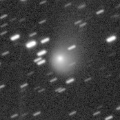
|
Now it is 13.5 mag (July 12, Chris Wyatt). It is expected to be observable at 5-6 mag for a long time from 2022 to 2023. In the Northern Hemisphere, it is not observable at the high light from 2022 summer to 2023 summer. In the Southern Hemisphere, it stays extremely low for a while. But it will be observable in good condition at the high light.
Date(TT) R.A. (2000) Decl. Delta r Elong. m1 Best Time(A, h)
July 17 17 19.30 40 50.9 5.435 5.850 109 12.3 21:37 (180, 84)
July 24 17 14.01 39 51.8 5.410 5.791 107 12.3 21:04 (180, 85)
|
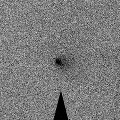
|
It brightened up to 10.1 mag in spring (Apr. 10, Marco Goiato). Now it is fading. It has already faded down to 13.6 mag (July 12, Chris Wyatt). It stays observable in good condition for a long time after this while the comet will fading.
Date(TT) R.A. (2000) Decl. Delta r Elong. m1 Best Time(A, h)
July 17 3 32.02 8 11.0 2.066 1.828 62 13.5 3:16 (275, 22)
July 24 3 45.03 8 33.4 2.046 1.870 65 13.6 3:23 (278, 26)
|

|
Now it is 13.8 mag (July 6, Chris Wyatt). It stays 13-14 mag from 2020 to 2021. It will be observable in good condition after this in the Southern Hemisphere. It locates somewhat low in the Northern Hemisphere.
Date(TT) R.A. (2000) Decl. Delta r Elong. m1 Best Time(A, h)
July 17 18 59.51 -34 15.8 1.979 2.967 163 13.8 23:17 ( 0, 21)
July 24 18 54.42 -34 44.6 2.015 2.977 157 13.8 22:45 ( 0, 20)
|
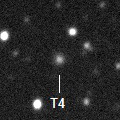
|
Now it is 14.6 mag (July 12, Chris Wyatt). It is expected to brighten up to 11.5 mag in 2022. In the Southern Hemisphere, it stas observable in good condition for a long time, although it becomes extremely low temporarily from August to September. In the Northern Hemisphere, it is not observable until November.
Date(TT) R.A. (2000) Decl. Delta r Elong. m1 Best Time(A, h)
July 17 9 17.56 -22 29.6 5.625 5.021 49 13.9 20:55 ( 81,-28)
July 24 9 25.15 -22 20.5 5.646 4.991 45 13.8 20:49 ( 83,-31)
|

|
Now it is bright as 13.4 mag (July 12, Chris Wyatt). It stays 13 mag until early summer. In the Southern Hemisphere, it stays observable in good condition for a long time. It locates somewhat low in the Northern Hemisphere.
Date(TT) R.A. (2000) Decl. Delta r Elong. m1 Best Time(A, h)
July 17 13 46.48 -9 51.7 3.237 3.458 93 13.8 20:55 ( 50, 30)
July 24 13 43.63 -8 38.6 3.392 3.475 86 14.0 20:49 ( 56, 27)
|
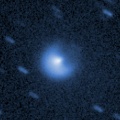
|
Appearing in the morning sky. Now it is faint as 16.5 mag (July 15, Jean-Francois Soulier).
Date(TT) R.A. (2000) Decl. Delta r Elong. m1 Best Time(A, h)
July 17 4 24.73 29 39.7 6.562 5.897 45 13.9 3:16 (248, 22)
July 24 4 29.81 29 54.9 6.483 5.898 51 13.8 3:23 (251, 28)
|
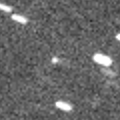
|
Now it is 15.0 mag (July 12, Chris Wyatt). It will brighten up to 9 mag, and will be observable in good condition in winter.
Date(TT) R.A. (2000) Decl. Delta r Elong. m1 Best Time(A, h)
July 17 1 2.79 1 55.8 1.286 1.761 99 14.5 3:16 (311, 46)
July 24 1 18.18 3 27.0 1.183 1.708 101 14.1 3:23 (315, 50)
|
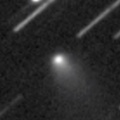
|
Now it is 14.9 mag (June 14, Michael Jager). It will brighten up to 14 mag in summer, and it will be observable in excellent condition. It locates somewhat low in the Southern Hemisphere.
Date(TT) R.A. (2000) Decl. Delta r Elong. m1 Best Time(A, h)
July 17 19 27.65 31 37.4 1.673 2.424 126 14.3 23:42 ( 0, 87)
July 24 18 54.01 32 33.4 1.678 2.401 124 14.2 22:42 ( 0, 88)
|
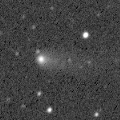
|
Now it is 14.8 mag (July 12, Chris Wyatt). It was expected to brighten up to 13 mag from spring to summer. But actually, it is fainter than originally expected. It stays 14-15 mag until early autumn. In the Southern Hemisphere, it stays observable in good condition for a long time. In the Northern Hemisphere, it is not observable until July in 2022.
Date(TT) R.A. (2000) Decl. Delta r Elong. m1 Best Time(A, h)
July 17 0 17.72 -86 34.5 3.089 3.602 112 14.6 3:16 (359,-32)
July 24 0 15.34 -87 7.4 3.111 3.607 111 14.6 3:23 (359,-32)
|
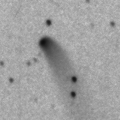
|
Now it is 14.9 mag (July 12, Chris Wyatt). It stays 14-15 mag until the end of 2021. In the Southern Hemisphere, it stays observable in good condition for a long time. It locates low in the Northern Hemisphere.
Date(TT) R.A. (2000) Decl. Delta r Elong. m1 Best Time(A, h)
July 17 23 38.50 -34 12.4 3.737 4.429 127 14.6 3:16 (350, 20)
July 24 23 34.93 -34 8.1 3.682 4.441 133 14.6 3:23 (359, 21)
|

|
Now it is 15.0 mag (July 5, Chris Wyatt). It stays at 14-15 mag for a long time from 2021 to 2022. It stays observable in good condition after this while brightening gradually.
Date(TT) R.A. (2000) Decl. Delta r Elong. m1 Best Time(A, h)
July 17 16 48.31 -7 39.2 4.290 5.063 135 14.7 21:06 ( 0, 47)
July 24 16 42.16 -8 41.4 4.366 5.054 127 14.7 20:49 ( 6, 46)
|
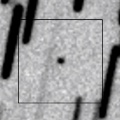
|
Now it is 16.7 mag (July 11, Ken-ichi Kadota). It will brighten very rapidly, and it will be observable at 10 mag in good condition from October to December. In the Northern Hemisphere, it locates somewhat low at the high light.
Date(TT) R.A. (2000) Decl. Delta r Elong. m1 Best Time(A, h)
July 17 16 9.83 9 36.4 0.756 1.531 118 15.5 20:55 ( 15, 64)
July 24 16 12.09 6 34.7 0.750 1.497 115 15.0 20:49 ( 23, 59)
|
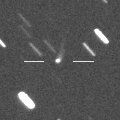
|
It will brighten up to 14.5 mag from spring to summer. In the Southern Hemisphere, it stays observable in excellent condition for a long time. In the Northern Hemisphere, it is not observable after this.
Date(TT) R.A. (2000) Decl. Delta r Elong. m1 Best Time(A, h)
July 17 8 19.81 -64 12.0 2.681 2.795 85 15.1 20:55 ( 31,-46)
July 24 8 50.13 -62 22.8 2.764 2.820 82 15.2 20:49 ( 34,-45)
|
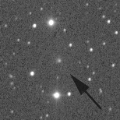
|
It brightened up to 14.2 mag in early summer (June 10, Thomas Lehmann). Now it is not observable. It will be fading after this. In the Northern Hemisphere, it will appear in the morning sky at 16 mag in October. In the Southern Hemisphere, it will never be observable again.
Date(TT) R.A. (2000) Decl. Delta r Elong. m1 Best Time(A, h)
July 17 9 29.40 12 36.4 2.826 1.968 26 15.2 20:55 (110, -6)
July 24 9 43.04 14 0.9 2.872 1.971 22 15.2 20:49 (112, -6)
|
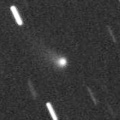
|
Now it is 15.8 mag (June 30, Thomas Lehmann). In the Northern Hemisphere, it stays observable at 15-16 mag for a long time from spring to early 2022. In the Southern Hemisphere, it is not observable until the end of 2021.
Date(TT) R.A. (2000) Decl. Delta r Elong. m1 Best Time(A, h)
July 17 12 22.63 57 21.7 3.379 3.023 61 15.4 20:55 (138, 43)
July 24 12 22.47 54 9.1 3.431 3.016 57 15.4 20:49 (134, 40)
|
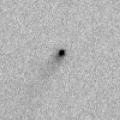
|
Now it is 16.7 mag (June 11, J. L. Virlichie, P. Traverse, J. P. Desgrees). It will brighten up to 15 mag from summer to autumn. In the Southern Hemisphere, it stays observable for a long time. In the Northern Hemisphere, it will be getting higher gradually after this, and it will be observable in good condition after summer.
Date(TT) R.A. (2000) Decl. Delta r Elong. m1 Best Time(A, h)
July 17 3 43.81 12 0.4 1.844 1.568 58 15.5 3:16 (270, 21)
July 24 4 3.31 14 4.9 1.795 1.553 59 15.4 3:23 (270, 26)
|

|
Now it is 15.8 mag (July 10, Thomas Lehmann). It will brighten up to 13 mag in 2022. In 2021, it is observable at 14-15 mag in good condition.
Date(TT) R.A. (2000) Decl. Delta r Elong. m1 Best Time(A, h)
July 17 13 10.68 -3 34.3 3.444 3.476 83 15.4 20:55 ( 62, 28)
July 24 13 15.19 -4 18.3 3.527 3.461 77 15.4 20:49 ( 65, 25)
|

|
It brightened up to 11.6 mag in winter (Feb. 18, Thomas Lehmann). Now it is fading. It has already faded down to 15.2 mag (June 22, Thomas Lehmann). In the Southern Hemisphere, it stays observable in good condition after this. In the Northern Hemisphere, it will never be observable after this.
Date(TT) R.A. (2000) Decl. Delta r Elong. m1 Best Time(A, h)
July 17 5 27.49 -54 33.4 3.247 3.253 81 15.4 3:16 (317,-32)
July 24 5 30.33 -55 31.6 3.286 3.318 82 15.5 3:23 (320,-28)
|
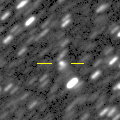
|
Now it is 15.6 mag (June 26, ATLAS-MLO, Mauna Loa). It stays observable at 15-16 mag in good condition until autumn.
Date(TT) R.A. (2000) Decl. Delta r Elong. m1 Best Time(A, h)
July 17 16 35.98 -16 35.5 4.099 4.874 135 15.6 20:55 ( 0, 38)
July 24 16 33.33 -15 35.7 4.182 4.870 127 15.7 20:49 ( 8, 39)
|
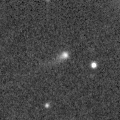
|
Now it is 17.0 mag (June 16, Michael Jager). It will approach to Earth down to 0.2 a.u. in December, and it is expected to brighten up to 4 mag. In the Northern Hemisphere, it stays observable in good condition for a long time until December while the comet is brightening gradually. In the Southern Hemisphere, it is not observable until mid December. Actually, it is somewhat fainter than this ephemeris recently.
Date(TT) R.A. (2000) Decl. Delta r Elong. m1 Best Time(A, h)
July 17 10 30.05 48 41.3 3.554 2.890 42 15.9 20:55 (133, 25)
July 24 10 32.26 47 28.3 3.511 2.801 39 15.7 20:49 (134, 21)
|
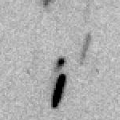
|
Now it is 17.0 mag (June 25, ATLAS-HKO, Haleakala). It is expected to brighten up to 15 mag from summer to autumn, and it will be observable in good condition. However, it is fainter than this ephemeris recently.
Date(TT) R.A. (2000) Decl. Delta r Elong. m1 Best Time(A, h)
July 17 23 18.56 -5 35.7 1.582 2.330 126 15.8 3:16 (351, 49)
July 24 23 21.43 -6 6.8 1.514 2.323 132 15.7 3:15 ( 0, 49)
|

|
Now it is 15.7 mag (June 9, Toshihiko Ikemura, Hirohisa Sato). It is expected to brighten up to 13 mag in 2022. In the Southern Hemisphere, it stays observable in good condition for a long time. In the Northern Hemisphere, it will be unobservable soon.
Date(TT) R.A. (2000) Decl. Delta r Elong. m1 Best Time(A, h)
July 17 12 0.25 -21 6.6 4.586 4.439 75 15.8 20:55 ( 61, 4)
July 24 12 0.13 -21 28.0 4.651 4.395 69 15.8 20:49 ( 64, 0)
|
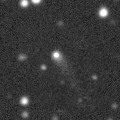
|
Now it is 16.2 mag (June 25, ATLAS-HKO, Haleakala). It stays observable at 16 mag from 2021 to 2022.
Date(TT) R.A. (2000) Decl. Delta r Elong. m1 Best Time(A, h)
July 17 13 39.57 0 25.1 4.657 4.741 88 16.0 20:55 ( 60, 36)
July 24 13 41.43 0 58.0 4.764 4.735 82 16.0 20:49 ( 64, 33)
|
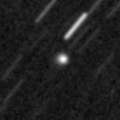
|
Now it is 16.7 mag (July 1, Thomas Lehmann). It is expected to brighten up to 11 mag in 2023. In the Northern Hemisphere, it stays observable in good condition for a long time. It locates extremely low in the Southern Hemisphere.
Date(TT) R.A. (2000) Decl. Delta r Elong. m1 Best Time(A, h)
July 17 16 42.73 49 8.0 6.154 6.389 98 16.0 21:00 (180, 76)
July 24 16 35.16 48 19.1 6.154 6.345 96 16.0 20:49 (164, 76)
|
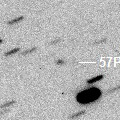
|
Now it is 17.3 mag (June 13, Francois Kugel). It will brighten up to 15.5 mag from summer to autumn. It stays observable for a long time.
Date(TT) R.A. (2000) Decl. Delta r Elong. m1 Best Time(A, h)
July 17 15 11.70 -13 36.3 1.252 1.915 114 16.1 20:55 ( 26, 37)
July 24 15 17.16 -14 4.1 1.288 1.889 109 16.0 20:49 ( 30, 35)
|

|
Now it is 15.7 mag (June 9, Toshihiko Ikemura, Hirohisa Sato). In the Northern Hemisphere, it stays observable for a long time while it is getting fainter slowly. In the Southern Hemisphere, it will never be observable again.
Date(TT) R.A. (2000) Decl. Delta r Elong. m1 Best Time(A, h)
July 17 13 29.97 56 31.6 6.577 6.308 70 16.1 20:55 (139, 52)
July 24 13 30.68 55 10.3 6.671 6.357 67 16.1 20:49 (136, 50)
|
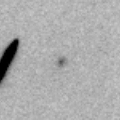
|
Now it is 17.1 mag (June 10, J. L. Virlichie, P. Traverse, J. P. Desgrees). It will brighten rapidly up to 15 mag in autumn. It will be observable in excellent condition in the Northern Hemisphere. It locates somewhat low in the Southern Hemisphere.
Date(TT) R.A. (2000) Decl. Delta r Elong. m1 Best Time(A, h)
July 17 3 6.57 10 57.7 1.869 1.747 67 16.4 3:16 (277, 28)
July 24 3 24.02 12 33.9 1.802 1.727 69 16.2 3:23 (278, 33)
|
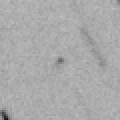
|
Now it is 18.6 mag (June 25, L. Buzzi, L. Demetz, N. Paul, A. Aletti). It will brighten rapidly up to 9 mag in winter. It will be observable in good condition.
Date(TT) R.A. (2000) Decl. Delta r Elong. m1 Best Time(A, h)
July 17 0 6.00 -43 23.0 1.781 2.477 122 16.6 3:16 (347, 10)
July 24 0 11.24 -45 8.9 1.692 2.425 125 16.3 3:23 (353, 9)
|
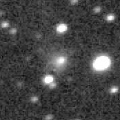
|
Now it is 16.6 mag (June 29, ATLAS-MLO, Mauna Loa). It is observable at 16 mag from 2020 to 2021. It locates low in the Southern Hemisphere.
Date(TT) R.A. (2000) Decl. Delta r Elong. m1 Best Time(A, h)
July 17 22 58.74 45 14.2 5.759 6.023 100 16.3 3:16 (184, 80)
July 24 22 52.83 45 3.1 5.679 6.031 105 16.3 2:47 (180, 80)
|
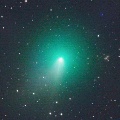
|
It brightened up to 8.9 mag in April (Apr. 12, Carlos Labordena). Now it is fading. It has already faded down to 16.0 mag (July 8, Thomas Lehmann). It will be fading and getting lower rapidly after this. It will be unobservable at 17 mag in July.
Date(TT) R.A. (2000) Decl. Delta r Elong. m1 Best Time(A, h)
July 17 10 58.18 14 30.6 2.901 2.318 46 16.3 20:55 ( 99, 13)
July 24 11 0.61 13 44.2 3.081 2.400 40 16.6 20:49 (101, 8)
|
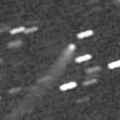
|
Now it is 16.0 mag (June 27, ATLAS-HKO, Haleakala). Fading slowly. In the Northern Hemisphere, it stays observable in good condition for a long time. It is not observable after this in the Southern Hemisphere.
Date(TT) R.A. (2000) Decl. Delta r Elong. m1 Best Time(A, h)
July 17 17 2.97 57 32.4 5.303 5.474 94 16.3 21:20 (180, 68)
July 24 16 52.29 57 5.5 5.369 5.505 92 16.4 20:49 (178, 68)
|
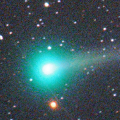
|
It brightened up to 3 mag in December in the SOHO spacecraft images (Dec. 18, Hirohisa Sato). Now it is 15.6 mag (June 15, Michael Jager). It stays observable in good condition after this while the comet will be fading.
Date(TT) R.A. (2000) Decl. Delta r Elong. m1 Best Time(A, h)
July 17 0 19.23 19 59.6 3.260 3.600 101 16.4 3:16 (303, 66)
July 24 0 16.68 20 8.5 3.238 3.684 108 16.4 3:23 (321, 72)
|
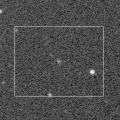
|
Now it is 16.9 mag (July 7, Thomas Lehmann). It will brighten up to 12.5 mag in 2022 summer. In the Southern Hemisphere, it stays observable in excellent condition for a long time. In the Northern Hemisphere, it is not observable until August in 2022.
Date(TT) R.A. (2000) Decl. Delta r Elong. m1 Best Time(A, h)
July 17 3 52.75 -49 36.9 4.931 4.991 87 16.4 3:16 (319,-17)
July 24 3 55.99 -51 12.3 4.827 4.942 90 16.4 3:23 (324,-14)
|
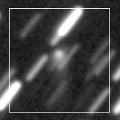
|
Now it is 16.2 mag (June 29, ATLAS-MLO, Mauna Loa). It stays at 16-17 mag from 2020 to 2021. In the Northern Hemisphere, it stays observable in good condition for a long time. It locates extremely low in the Southern Hemisphere.
Date(TT) R.A. (2000) Decl. Delta r Elong. m1 Best Time(A, h)
July 17 18 59.22 51 32.5 8.509 8.852 106 16.4 23:16 (180, 73)
July 24 18 53.52 51 41.1 8.517 8.856 106 16.4 22:43 (180, 73)
|
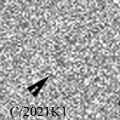
|
Now it is 16.1 mag (June 17, ATLAS-HKO, Haleakala). It stays 16.5 mag until August and stays observable in good condition.
Date(TT) R.A. (2000) Decl. Delta r Elong. m1 Best Time(A, h)
July 17 0 54.00 -4 9.8 2.167 2.598 103 16.4 3:16 (318, 42)
July 24 1 0.34 -4 33.8 2.109 2.617 108 16.4 3:23 (327, 45)
|

|
Announced as a bright Centaur-type asteroid. But Hidetaka Sato revealed that this is Phoebe, one of the satellites of Saturn.
Date(TT) R.A. (2000) Decl. Delta r Elong. m1 Best Time(A, h)
July 17 20 56.44 -18 4.1 8.894 9.870 162 16.5 1:18 ( 0, 37)
July 24 20 54.57 -18 12.8 8.869 9.871 170 16.5 0:49 ( 0, 37)
|
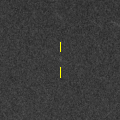
|
Now it is 18.1 mag (June 18, W. Hasubick). It will brighten up to 15-16 mag in autumn and it will be observable in good condition.
Date(TT) R.A. (2000) Decl. Delta r Elong. m1 Best Time(A, h)
July 17 23 34.62 -4 35.0 1.472 2.187 121 16.7 3:16 (345, 49)
July 24 23 36.69 -3 39.4 1.405 2.181 127 16.5 3:23 (357, 51)
|
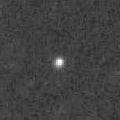
|
Now it is 16.6 mag (June 29, ATLAS-MLO, Mauna Loa). It is expected to brighten up to 10 mag in 2023. In the Northern Hemisphere, it stays observable in good condition until 2023 autumn. In the Southern Hemipshere, it stays extremely low until mid July, then it becomes unobservable for a while. But it becomes observable in good condition after 2023 summer.
Date(TT) R.A. (2000) Decl. Delta r Elong. m1 Best Time(A, h)
July 17 12 1.19 36 45.0 7.311 6.812 57 16.7 20:55 (113, 35)
July 24 12 2.14 36 22.4 7.331 6.758 52 16.6 20:49 (115, 32)
|

|
It had been observed as 8-9 mag for a long time in 2020. Now it is fading. It has already faded down to 16.8 mag (July 9, Thomas Lehmann). It will be observable in good condition after this in the Southern Hemisphere. It locates extremely low after this in the Northern Hemisphere.
Date(TT) R.A. (2000) Decl. Delta r Elong. m1 Best Time(A, h)
July 17 16 15.06 -46 19.7 4.482 5.204 130 16.7 20:55 ( 4, 8)
July 24 16 11.66 -46 8.8 4.622 5.266 124 16.8 20:49 ( 8, 8)
|
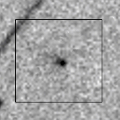
|
Now it is 18.1 mag (June 29, Thomas Lehmann). It will be observable at 11 mag from winter to spring in 2022. In 2021, it is observable until July or August when it brightens up to 16-17 mag.
Date(TT) R.A. (2000) Decl. Delta r Elong. m1 Best Time(A, h)
July 17 11 12.05 8 57.1 3.206 2.689 51 16.9 20:55 ( 92, 12)
July 24 11 20.80 7 59.4 3.235 2.647 46 16.7 20:49 ( 93, 9)
|
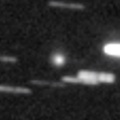
|
Now it is 16.7 mag (June 25, ATLAS-MLO, Mauna Loa). It is expected to brighten up to 11 mag in 2023. In the Northern Hemisphere, it is observable in good condition in 2021. But it is observable only until November in 2022. In the Southern Hemisphere, it locates extremely low in 2021. But it will be observable in good condition at the high light.
Date(TT) R.A. (2000) Decl. Delta r Elong. m1 Best Time(A, h)
July 17 17 49.57 44 15.1 6.228 6.635 109 16.8 22:07 (180, 81)
July 24 17 44.42 43 23.1 6.200 6.587 108 16.8 21:34 (180, 82)
|
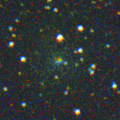
|
Now it is 17.0 mag (June 24, Slooh.com Canary Islands Observatory). In the Northern Hemisphere, it stays observable in good condition while the comet will be fading. In the Southern Hemipsphere, it stays locating extremely low after this. Thomas Lehmann reported it was bright as 15.0 mag on July 9.
Date(TT) R.A. (2000) Decl. Delta r Elong. m1 Best Time(A, h)
July 17 3 53.14 35 55.3 2.843 2.361 52 16.8 3:16 (245, 31)
July 24 4 7.04 37 1.2 2.805 2.386 55 17.0 3:23 (246, 35)
|
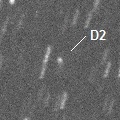
|
Now it is 17.4 mag (June 21, ATLAS-MLO, Mauna Loa). It will brighten up to 15.5 mag in winter. In the Northern Hemisphere, it stays observable in good condition for a long time. It is not observable at all in the Southern Hemisphere.
Date(TT) R.A. (2000) Decl. Delta r Elong. m1 Best Time(A, h)
July 17 19 26.83 72 52.8 3.482 3.556 85 16.9 23:41 (180, 52)
July 24 18 53.45 73 54.7 3.454 3.519 85 16.9 22:40 (180, 51)
|
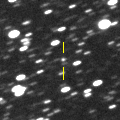
|
Now it is 17.1 mag (June 27, ATLAS-HKO, Haleakala). It is expected to brighten up to 11 mag from spring to summer in 2022. In the Southen Hemisphere, it locates somewhat low in 2021, but it will be observable in good condition at the high light for a long time. In the Northern Hemisphere, it is observable in good condition in 2021, but it will not be observable at the high light.
Date(TT) R.A. (2000) Decl. Delta r Elong. m1 Best Time(A, h)
July 17 20 2.42 37 19.4 3.575 4.194 121 17.0 0:24 (180, 88)
July 24 19 51.71 36 29.0 3.484 4.131 123 16.9 23:41 (180, 89)
|

|
Now it is 19.7 mag (June 12, Francois Kugel). It will brighten very rapidly up to 14 mag, and it will be observable in excellent condition in autumn.
Date(TT) R.A. (2000) Decl. Delta r Elong. m1 Best Time(A, h)
July 17 23 49.98 2 10.2 1.386 2.044 115 17.2 3:16 (335, 55)
July 24 23 57.46 2 44.9 1.293 2.009 120 16.9 3:23 (347, 57)
|
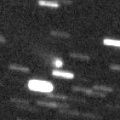
|
Now it is 16.4 mag (June 28, ATLAS-HKO, Haleakala). It will be fading after this, and it will be fainter than 18 mag in October.
Date(TT) R.A. (2000) Decl. Delta r Elong. m1 Best Time(A, h)
July 17 15 30.00 -20 16.2 4.456 5.053 120 16.9 20:55 ( 19, 32)
July 24 15 24.39 -20 38.1 4.592 5.075 112 17.0 20:49 ( 25, 30)
|
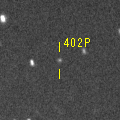
|
First return of a new periodic comet observed at 16 mag from 2003 to 2004. Now it is 16.8 mag (Apr. 11, J. Drummond). It will brighten up to 16 mag in winter, and it will be observable in excellent condition. It will be getting higher gradually.
Date(TT) R.A. (2000) Decl. Delta r Elong. m1 Best Time(A, h)
July 17 5 24.49 2 9.5 4.767 4.031 39 17.0 3:16 (264, -5)
July 24 5 32.28 2 18.0 4.705 4.023 43 16.9 3:23 (268, 1)
|
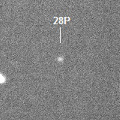
|
Now it is 16.0 mag (June 25, Slooh.com Canary Islands Observatory). In the Northern Hemisphere, it stays observable in good condition after this while the comet will be fading. In the Southern Hemisphere, it stays locating extremely low for a long time.
Date(TT) R.A. (2000) Decl. Delta r Elong. m1 Best Time(A, h)
July 17 3 52.94 30 1.3 2.619 2.156 52 17.0 3:16 (252, 28)
July 24 4 5.94 31 10.8 2.606 2.208 56 17.1 3:23 (253, 33)
|
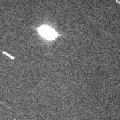
|
First return of a new periodic comet observed at 17 mag in 2014. It has not been observed yet in this apparition. It is expected to brighten up to 17 mag from summer to autumn, and it will be observable in good condition.
Date(TT) R.A. (2000) Decl. Delta r Elong. m1 Best Time(A, h)
July 17 1 33.25 18 19.5 1.429 1.696 86 17.1 3:16 (285, 51)
July 24 1 46.34 20 17.1 1.388 1.708 89 17.0 3:23 (287, 57)
|

|
Appearing in the morning sky. In the Northern Hemisphere, it stays observable at 17 mag in good condition until winter. In the Southern Hemisphere, it stays locating extremely low for a while.
Date(TT) R.A. (2000) Decl. Delta r Elong. m1 Best Time(A, h)
July 17 4 46.16 37 27.0 2.554 1.919 41 17.3 3:16 (239, 22)
July 24 5 7.81 37 50.3 2.517 1.918 43 17.2 3:23 (240, 24)
|

|
Now it is 16.8 mag (June 10, Toshihiko Ikemura, Hirohisa Sato). It will be fading slowly.
Date(TT) R.A. (2000) Decl. Delta r Elong. m1 Best Time(A, h)
July 17 17 14.36 -11 52.9 6.997 7.830 142 17.3 21:32 ( 0, 43)
July 24 17 9.99 -11 39.3 7.101 7.856 135 17.4 21:01 ( 0, 43)
|
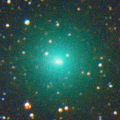
|
It brightened up to 8.2 mag in 2020 autumn (Oct. 13, 2020, Chris Wyatt). It is observable at 18 mag in 2021.
Date(TT) R.A. (2000) Decl. Delta r Elong. m1 Best Time(A, h)
July 17 4 22.30 21 17.3 3.552 2.954 47 17.4 3:16 (256, 18)
July 24 4 30.72 21 40.2 3.516 2.994 51 17.5 3:23 (259, 24)
|
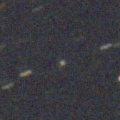
|
Now it is 17.4 mag (June 26, Michael Jager). It stays observable at 17-18 mag for a long time until 2024.
Date(TT) R.A. (2000) Decl. Delta r Elong. m1 Best Time(A, h)
July 17 14 24.02 -5 39.2 8.815 9.066 101 17.4 20:55 ( 44, 39)
July 24 14 22.27 -5 31.7 8.928 9.057 94 17.4 20:49 ( 50, 35)
|
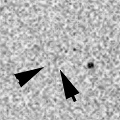
|
Now it is 20 mag (May 28, Giuseppe Pappa). It will brighten up to 14.5 mag in 2022 winter. In 2021, it stays observable in good condition while the comet will be brightening gradually.
Date(TT) R.A. (2000) Decl. Delta r Elong. m1 Best Time(A, h)
July 17 23 8.36 -12 55.8 2.621 3.375 130 17.5 3:16 (355, 42)
July 24 23 7.60 -13 22.3 2.526 3.349 137 17.4 3:01 ( 0, 42)
|
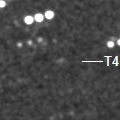
|
Now it is extremely faint as 20.5 mag (June 17, M. Jaeger, E. Prosperi, S. Prosperi). It was predicted to brighten up to 17.5 mag in 2021 summer. But actually, it is much fainter than predicted. It is not observable in the Southern Hemisphere.
Date(TT) R.A. (2000) Decl. Delta r Elong. m1 Best Time(A, h)
July 17 10 1.65 77 42.1 2.544 2.196 58 17.4 20:55 (165, 33)
July 24 11 14.36 74 49.4 2.530 2.203 59 17.4 20:49 (161, 35)
|

|
First return of a new periodic comet which brightened up to 17 mag in 2012. Now it is 18.3 mag (June 30, ATLAS-MLO, Mauna Loa). In the Southern Hemisphere, it is observable at 17.5 mag in excellent condition in summer. It locates low in the Northern Hemisphere.
Date(TT) R.A. (2000) Decl. Delta r Elong. m1 Best Time(A, h)
July 17 19 59.50 -37 59.0 0.853 1.848 162 17.6 0:22 ( 0, 17)
July 24 19 53.49 -39 10.0 0.809 1.798 160 17.5 23:44 ( 0, 16)
|
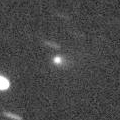
|
First return of a new periodic comet which brightened up to 16 mag in 2014. Now it is 16.9 mag (July 5, Thomas Lehmann). It stays observable at 16-17 mag in good condition until July.
Date(TT) R.A. (2000) Decl. Delta r Elong. m1 Best Time(A, h)
July 17 12 55.54 -7 27.0 2.043 2.140 81 17.5 20:55 ( 62, 23)
July 24 13 5.33 -9 11.7 2.115 2.140 77 17.6 20:49 ( 62, 20)
|
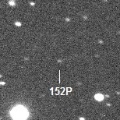
|
Now it is 17.5 mag (June 14, Toshihiko Ikemura, Hirohisa Sato). It will brighten up to 16 mag in 2022. In 2021, it stays observable at 18 mag until September.
Date(TT) R.A. (2000) Decl. Delta r Elong. m1 Best Time(A, h)
July 17 13 31.71 -0 53.4 3.129 3.243 87 17.8 20:55 ( 60, 34)
July 24 13 36.49 -1 46.3 3.213 3.232 82 17.8 20:49 ( 63, 30)
|
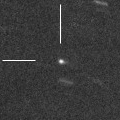
|
Now it is 17.8 mag (July 11, N. Paul). It is observable at 17 mag in good condition in autumn.
Date(TT) R.A. (2000) Decl. Delta r Elong. m1 Best Time(A, h)
July 17 2 6.90 17 49.6 3.946 3.877 78 17.9 3:16 (279, 44)
July 24 2 12.21 18 9.6 3.841 3.871 84 17.8 3:23 (284, 50)
|

|
First return of a new periodic comet which brightened up to 17 mag in 2006. Now it is 17.4 mag (June 15, Taras Prystavski). It stays 18 mag from 2021 to 2022.
Date(TT) R.A. (2000) Decl. Delta r Elong. m1 Best Time(A, h)
July 17 22 49.20 -67 38.0 2.650 3.345 125 17.9 3:11 ( 0,-12)
July 24 22 44.90 -68 26.9 2.626 3.328 126 17.8 2:39 ( 0,-13)
|

|
It brightened up to 18.5 mag in 2020 spring (Apr. 2, 2020, W. Hasubick). It has passed the perihelion in 2020 October. At the discovery in 2005, it stayed bright for several years even after the perihelion passage. In this apparition, it may stay observable at 18 mag from 2021 to 2024.
Date(TT) R.A. (2000) Decl. Delta r Elong. m1 Best Time(A, h)
July 17 23 50.91 -23 22.8 3.122 3.780 123 17.9 3:16 (345, 30)
July 24 23 51.40 -24 5.0 3.070 3.799 129 17.9 3:23 (354, 31)
|
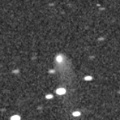
|
It brightened up to 13.8 mag in autumn in 2019 (Sept. 3, 2019, Chris Wyatt). Now it is fading slowly. It stays 18 mag until autumn.
Date(TT) R.A. (2000) Decl. Delta r Elong. m1 Best Time(A, h)
July 17 0 50.04 20 15.8 7.972 8.120 94 17.9 3:16 (292, 61)
July 24 0 49.38 20 40.2 7.905 8.163 101 17.9 3:23 (304, 67)
|
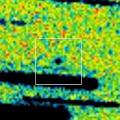
|
It was expected to brighten up to 13 mag from spring to summer. But actually, it is extremely faint as 17.9 mag (Apr. 5, J. L. Virlichie, P. Traverse, J. P. Desgrees). In the Southern Hemisphere, it stays observable in good condition for a long time. In the Northern Hemisphere, it is not observable until late August.
Date(TT) R.A. (2000) Decl. Delta r Elong. m1 Best Time(A, h)
July 17 5 28.57 -29 13.7 1.886 1.639 60 19.6 3:16 (291,-23)
July 24 5 42.08 -27 46.3 1.931 1.674 60 19.7 3:23 (292,-18)
|
|
![]()
 193P/LINEAR-NEAT
193P/LINEAR-NEAT C/2020 V2 ( ZTF )
C/2020 V2 ( ZTF ) C/2017 T2 ( PanSTARRS )
C/2017 T2 ( PanSTARRS ) 22P/Kopff
22P/Kopff C/2020 K1 ( PanSTARRS )
C/2020 K1 ( PanSTARRS ) 17P/Holmes
17P/Holmes C/2021 D2 ( ZTF )
C/2021 D2 ( ZTF ) C/2021 E3 ( ZTF )
C/2021 E3 ( ZTF ) 132P/Helin-Roman-Alu 2
132P/Helin-Roman-Alu 2 C/2017 Y2 ( PanSTARRS )
C/2017 Y2 ( PanSTARRS ) 402P/2020 Q3 ( LINEAR )
402P/2020 Q3 ( LINEAR ) 28P/Neujmin 1
28P/Neujmin 1 P/2014 W12 ( Gibbs )
P/2014 W12 ( Gibbs ) 241P/LINEAR
241P/LINEAR C/2017 U7 ( PanSTARRS )
C/2017 U7 ( PanSTARRS ) 88P/Howell
88P/Howell C/2020 F2 ( ATLAS )
C/2020 F2 ( ATLAS ) 119P/Parker-Hartley
119P/Parker-Hartley C/2020 T4 ( PanSTARRS )
C/2020 T4 ( PanSTARRS ) P/2021 L5 ( La Sagra )
P/2021 L5 ( La Sagra ) 413P/2020 W4 ( Larson )
413P/2020 W4 ( Larson ) 152P/Helin-Lawrence
152P/Helin-Lawrence P/2021 N2 ( Fuls )
P/2021 N2 ( Fuls ) P/2021 L1 ( Christensen )
P/2021 L1 ( Christensen ) 378P/2019 E2 ( McNaught )
378P/2019 E2 ( McNaught ) C/2017 B3 ( LINEAR )
C/2017 B3 ( LINEAR ) C/2020 K5 ( PanSTARRS )
C/2020 K5 ( PanSTARRS )![]()






























































